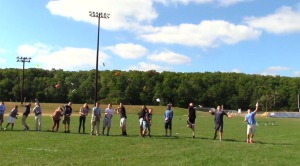Green Rockets ! Space Exploration & Rocketry Class @ STEM Academy

by Annie Cloutier, Science Teacher – Sandwich High School & STEM Academy
Space Exploration and Rocketry is an elective course for students at the STEM Academy.
If you drove down Quaker Meeting House Road during the third week of September, you might have seen a small rocket soaring 264 feet into the air. It was not from Camp Edwards- Otis Air Force Base, it was the creation of the 7th & 8th grade STEM students in Ms. Cloutier’s Space Exploration class.
The sunny and hot day greeted us as we moved from our classroom to the grassy soccer field on campus. Here, the STEM Academy students tested the first Green Rocket and Gliders.
Each flying machine proved in its own design, the Bernoulli Principle. Lift., thrust, force, gravity, and the effects of friction and drag were observed. Swiss physicist Daniel Bernoulli discovered and measured the physics of flight, now called the Bernoulli Principle.
Lift is the reaction that allows planes and rockets to move through the air and how birds’ wings allow them to fly. As a plane moves forward the approaching air splits up and under the wing. The air pressure must move faster over the top of the wing and slower under the wing during the same amount of time. The pressure is lower above the wing and higher below the wing, and this is how the plane is lifted up ! The different pressures cause the phenomenon called the Bernoulli Principle.
In the Third Law of Motion, Isaac Newton stated in the Third Law of Motion that “For every action, there is an equal and opposite reaction”. Wing designs vary, and the reaction of air coming at the wing (tilt & shape) may have an opposite reaction to the deflected air. Air bouncing off the bottom of a wing (the action of wind) will push the wing upward (the reaction) producing the lift needed to move the plane forward and up !
Not too windy; it was perfect environment to observe and understand rockets and planes through Project Based Learning.
The STEM Academy Television Production Class taught by Mr. Childress made their first video of the year at the Rocket Launch! Watch it here.
The Green Rockets were made entirely of recycled materials – old shiny paper magazines, two 2 liter soda bottles, and tape. Our construction tools were scissors, rulers and patterns.
How did they work?
- For POWER: We used recycled soda bottles for the fuel of captured gases in the empty bottle. The air gases inside the bottle created THRUST. That released the force of GRAVITY on the rocket. *The gases would provide air pressure for the displacement of gases as they were forced into a narrow plastic tube and cylinder.
- For STABILITY of the launch pad: We used a two liter soda bottle, half filled with water. It was held secure on the launch pad (large one inch block of wood) by being placed in a plastic flower pot that had been screwed down into the block of wood.
- The launch structure has a black plastic tube 1.5 cm round and 20cm long that the students place the hand-made rockets on.
- For FORCE: With a great leap, the student steps on the two liter ground bottle. The displaced gases inside the large bottle being forced into the narrow tube, concentrated the gases resulting in LIFT. *this should result in lift of the rocket IF the rocket was tightly wrapped in assembly. If not , a new one needs to be constructed more carefully.
- Using a Clinometer (altitude finder), students learned to operate simplified geometry technology and record the data for a graph. The procedure was to aim at launching rocket before take off, click and follow the rocket to its highest altitude and then, click to lock in the angle of altitude
- The best height we achieved was 264 feet.
- Problems we faced were tears in the rocket and uneven opening allowing fuel to escape from launcher.
Each student is in the process of perfecting the Green Rockets for trials next week.
We also worked with Gliders:
Students lined up on the center line of the soccer field to compete for the highest altitude and the greatest distance reached by their fluorescent color glider. The results varied with six variations of planes. Students learned to follow directions for cutting and folding, with folding edges equaled greater success of planes. Students constructed them out of colorful paper, and six choices of template for the Delta, the Conrad, the Dragonfly, the Bulldog, the Raptor, and the Interceptor.

You can click on “Gliders” to learn more about the different kinds of paper gliders that the students created and flew.
